Neurussland |
|
|
|
| Übersicht – Contents: | |
Diese Seite ist Teil des Projektes
Neurussland |
|
|
|
| Übersicht – Contents: | |
Flaggen – Flags: |
|
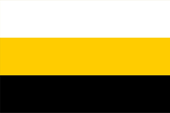 |
2014–2015, |
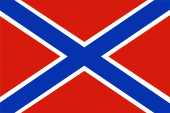 |
2014–2015, |
andere Flaggen – other Flags: |
|
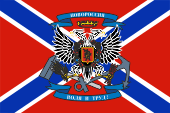 |
2014–2015, |
Bedeutung/Ursprung der Flagge – Meaning/Origin of the Flag: |
|
| Als Nationalflagge wurde offiziell eine waagerecht dreistreifige Flagge in Weiß, Gelb und Schwarz verwendet. Sie ähnelt der Flagge des Russischen Reiches zwischen 1858 und 1915 (in umgekehrter Reihenfolge). Schwarz und Gold sind die Wappenfarben (schwarzer Adler auf goldenem Grund), Weiß ist die Farbe des Heiligen Georg. | As national flag was officially used an horizontally three-striped flag in white, yellow and black is also used. It is similar to the flag of the Russian Empire between 1858 and 1915 (colours are in reverse order). Black and gold are the colors of the coat of arms (black eagle on a golden background), white is the color of Saint George. |
| Die Kriegsflagge von Neurussland zeigte die Farben Russlands: Weiß, Blau und Rot, in einer Anordnung als blaues Diagonalkreuz mit weißem Rand auf rotem Untergrund. Der Ursprung liegt in der Flagge der Neurussland-Partei, die als erste für die Interessen eines Staates Neurussland auf dem Gebiet der Ukraine eingetreten ist. | The war flag
of New Russia showed the colors of Russia: white, blue and red, in an
arrangement as a blue diagonal cross with a white border on red ground. The origin lies in the flag of the New Russia party, which has occurred as a first for the interests of a state of New Russia on the territory of Ukraine. |
| Die Gestaltung der Flagge entspricht Designgrundlagen, die noch auf Zar Peter den Großen zurückgehen und sich in den historischen Flaggen Russlands wiederfinden lassen, in Flaggen von Kosakenverbänden (z.B. Semiretschensker Kosaken) und in der heutigen Marineflagge und Gösch Russlands. Die Farben Weiß, Blau, und Rot sind seit 1915 die Nationalfarben von Russland. Es gibt Versuche in die Flagge die Farbsymbolik der Südstaaten hineinzuinterpretieren, um einen Rassenkrieg der Russen gegen die Ukrainer zu unterstellen. Sie dienen allesamt nur dazu das politische Projekt "Neurussland" zu diskreditieren. Problematisch ist, dass sich sogar in Russland dafür Unterstützer finden, die trotz ihrer Unbildung in einflussreiche Positionen gelangen konnten und ihr bescheidenes Verständnis – moralisch aufgeladen – als "Wahrheit" präsentieren. |
The design of the flag corresponds to design
principles that go back to Tsar Peter the Great and can be found in the
historical flags of Russia, in flags of Cossack armies (e.g. Semirechye
Cossacks) and in the today's naval flag and naval Jack of Russia. The colors white, blue and red have been the national colors of Russia since 1915. There are attempts to interpret the color symbolism of the Confedered States into the flag in order to imply a racial war between the Russians and the Ukrainians. They all serve only to discretize the political project "New Russia". The problem is that even in Russia there are supporters supporters for this point of view who, despite their lack of education, were able to reach influential positions and present their humble understanding, morally charged, as "truth". |
| Quelle/Source: Volker Preuß, Wikipedia (EN), Wikipedia (DE) | |
Wappen – Coat of Arms: |
|
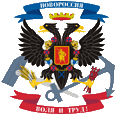 |
2014–2015, Wappen von Neurussland – coat of arms of New Russia, Quelle/Source nach/by: Wikipedia (EN) |
Bedeutung/Ursprung des Wappens – Meaning/Origin of the Coat of Arms: |
|
| Das Wappen zeigt den Russischen Adler. Er hält Pfeilbündel und Ähren in den Fängen, sitzt auf einem Hammer und einem Anker, und trägt eine Mauerkrone. Auf der Brust ein Brustschild, das einen Strelitzen zeigt. Das Staatsmotto ist: Wille und Arbeit! | The coat of arms shows the Russian eagle. It holds a bundle of arrows and ears in its claws, is sitting on a hammer and an anchor, and wears a mural crown. On the chest of a breastplate, showing a Sagittarius. The state motto is: will and work!. |
| Quelle/Source: Volker Preuß | |
regionale Flaggen – regional Flags: |
|
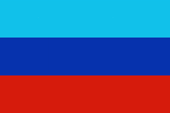 |
seit/since November 2014, |
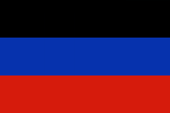 |
seit/from Sept. 2017, |
| Landkarte – Map: |
|
|
Zahlen und Fakten – Numbers and Facts: |
|
|
|
|
|
|
|
|
|
|
|
Geschichte: |
| Nach einem Putsch im Januar 2014 wurden die verfassungsmäßige Ordnung und der demokratisch gewählte Präsident der Ukraine beseitigt. Die neue Führung verfolgte eine nationalistische, antirussische Politik, die sich gegen die Rechte der nationalen Minderheit der Russen im Lande richtete – die immerhin 10% der Bevölkerung ausmacht – und z.B. Russisch als eine der Amtssprachen der Ukraine abschaffte. Die im Osten und Süden der Ukraine lebenden Russen organisierten sich und übernahmen lokal, in bestimmten Städten und Regionen, die Macht, und proklamierten verschiedene russische Volksrepubliken, die gegenüber der Ukraine Autonomie anstrebten. Die Republiken von Odessa und Charkow hatten keine lange Lebensdauer und fielen dem Krieg, den die Ukraine gegen die Republiken führte, zum Opfer. Nur die Volksrepubliken von Donezk und Lugansk konnten sich halten, und sie schlossen sich am 24.04.2014 zur Föderation Neurussland zusammen. Am 02.11. konnten in den Republiken erste Wahlen abgehalten werden, aus denen die prorussischen Kräfte als Sieger hervorgingen. Das Projekt "Föderation Neurussland" wurde am 20.05.2015 auf Grund des mangelnden Interesses der teilnehmenden Republiken angehalten bzw. eingestellt. |
History: |
| After a coup in January 2014, the constitutional order and the democratically elected President of Ukraine were eliminated. The new leadership pursued a nationalist, anti-Russian policy, which was directed against the rights of national minorities of Russians in the country – which accounts for at least 10% of the population – and e.g. abolished the Russian language as one of the official languages of the Ukraine. The in the east and south of the Ukraine living Russians organized themselves and took over the power locally, in specific cities and regions, and proclaimed several Russian people's republics who aspired autonomy towards the Ukraine. The republics of Odessa and Kharkov had no long life and perished in the war, which the Ukraine startet, on the republics. Only the People's Republics of Donetsk and Lugansk could withstand, and they joined on 24th of April in 2014 to the Federation of New Russia. On 2nd of November were organized first elections in the republics, and the pro-Russian forces had been the winners. The project of the "Federation New Russia" was halted/discontinued on 20th of May in 2015 due to the lack of interest from the participating republics. |
| Quelle/Source: Wikipedia (DE), Volker Preuß |
Ursprung des Landesnamens – Origin of the Country's Name: |
|
| Der geographische Begriff "Neurussland" entstand um das Jahr 1764, als es Russland gelang das Osmanische Reich aus der Region zwischen der Küste des Schwarzen Meeres, des Asowschen Meeres und der Ukraine zu vertreiben. Die Region wurde gezielt von ethnischen Russen und Deutschen besiedelt. Die russichen Bolschewisten schlossen Neurussland nach ihrem Putsch von 1917 an die Sowjet-Ukraine an. Noch heute besteht in Neurussland ein hoher Anteil von Russen. |
The geographical term "New Russia" is originated around the year 1764 when
Russia succeeded in driving the Ottoman Empire out of the region between the
coast of the Black Sea, the Sea of Azov and the Ukraine. The region was specifically populated by ethnic Russians and Germans. The Russian Bolsheviks annexed New Russia to the Soviet Ukraine after their 1917 coup. Even today there is a high proportion of Russians in New Russia. |
| Quelle/Source: Wikipedia (DE), Volker Preuß | |